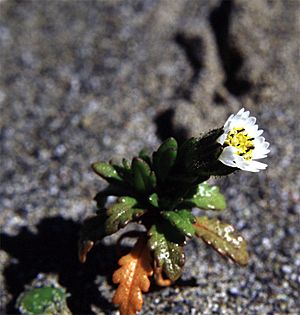Beach tidytips facts for kids
Quick facts for kids Layia carnosa |
|
|---|---|
 |
|
| Conservation status | |
| Scientific classification | |
| Kingdom: | |
| (unranked): | |
| (unranked): | |
| (unranked): | |
| Order: | |
| Family: | |
| Genus: |
Layia
|
| Species: |
L. carnosa
|
| Binomial name | |
| Layia carnosa (Nutt.) Torr. & A. Gray
|
|
Meet the Beach Tidytips! This special flowering plant, also called Beach Layia, is part of the daisy family. It's a unique plant that only grows in California, especially along its beaches. Sadly, it's an endangered species, meaning it's at risk of disappearing forever. It lives in only a few small areas along the coast. Both California and the United States government list it as endangered.
Contents
What is Beach Tidytips?
A Small but Mighty Plant
The Beach Tidytips is a small plant that grows for only one year. It usually stays close to the ground, but it can grow up to about 18 centimeters tall. That's about the length of a regular pencil! Its stem feels a bit sticky because it has tiny glands.
Leaves and Flowers
The leaves of this plant are green and feel a bit thick or fleshy. They are shaped like ovals. The bigger leaves can be up to 4 or 5 centimeters long and have a few gentle curves or lobes.
The flowers grow on a short stalk called a peduncle. Each flower head looks like a tiny cup made of green, overlapping leaves called phyllaries. Inside this cup, you'll find several small white petals, which are called ray florets. In the very center, there are many yellow disc florets. These yellow parts have purple anthers, which are part of the plant that makes pollen.
Seeds and How They Spread
After the flowers bloom, the plant produces small seeds. These seeds are called achenes. There are two kinds of seeds:
- The seeds from the white ray florets are usually hairy and curved. They don't have a special feathery top (called a pappus) to help them fly in the wind.
- The seeds from the yellow disc florets do have a long, hair-like pappus. This helps them float on the wind and spread to new places.


